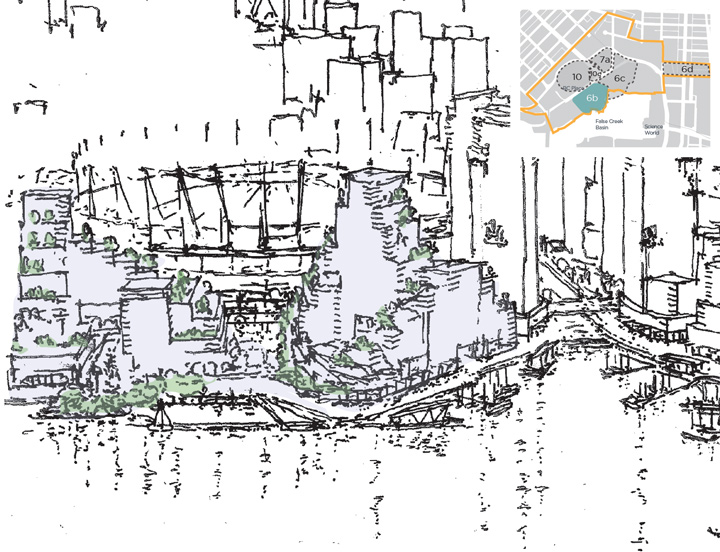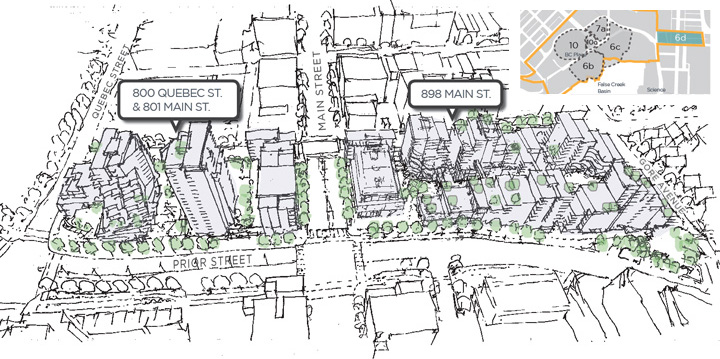

The Northeast False Creek Plan focuses on:
- Key relationships, edges, and interfaces between city and water
- Public places, supporting uses, and public views
- Built form in four development areas:
- Sub-area 6B (Plaza of Nations)
- Sub-area 6C
- Sub-area 10C
- Sub-area 6D
Explore the policy highlights for the development areas, below, along with what we heard and our changes in response.

Sub-area 6B (Plaza of Nations)
The Plaza of Nations site has a legacy as a place of gathering and celebration in the city, being the home of the Expo 86 BC Pavilion and the Plaza of Nations covered performance space.
Redevelopment will continue this legacy of public gathering and celebration in places and spaces that form the framework for the new site configuration.
Policy highlights
- Diversity of architecture
- New storefronts along Pacific Blvd
- Around 1.8 million square feet of new residential and non-residential uses
- Minimum 350,000 square feet of new non-residential job space
- Finegrain and permeable lower levels
- Around 2.5 acres of new parks and open space
- BC Place/waterfront connection plaza
- Terraced green roofs
- Interesting and inviting pedestrian waterfront
- Promontory-arts pavilion for waterfront arts and performance space
- Habitat water’s edge
- Views to stadium

Sub-area 6C
Sub-area 6C is pivotal in the meeting of city and water at the landing of Georgia St at False Creek, and in the shaping and activation of the new Creekside Park extension. It will be a critical part of creating and activating Pacific Blvd. It will have two major city-to-park connections – Carrall Greenway and the Dunsmuir Connection.
The densities, heights, and urban design parameters described in this sub-area are based on the requirement that all lands be jointly developed to create a cohesive and integrated waterfront district, which would not otherwise be possible through the development of the individual land holdings.
Policy highlights
- Frame the Georgia Landing and the alignment of Georgia St with the two tallest buildings of the development (about 425 feet)
- A network of finely scaled commercial and publicly active pedestrian lanes providing a unique experience
- About 2.1 million square feet of residential and non-residential uses
- Active uses and lower residential levels along Pacific Blvd
- Minimum 220,000 square feet of new job space
- Bring park and green planting up onto buildings along the Creekside Park frontage
- Support building design that encourages frequent breaks in the street frontage and allows connections to the neighbourhood and waterfront
- Human scale at the lower levels of buildings and design to create “sticky” edges
- Non-motorized boating facility
- Create smaller-scale food and beverage outlets and pavilions
- Design the wharf area to prioritize pedestrians, while accommodating dedicated cycling as part of the seawall
- Line the wharf and landing with active uses
- Shared vehicular access between Sub-Area 6C and Sub-Area 6B
- Reshape the waterfront to bring an inlet of water closes to Pacific Blvd and Georgia Landing

Sub-area 10C
Since the renovation of the stadium roof and introduction of the light ring, the stadium has become a valued icon of the Vancouver skyline. As such, one of the key urban design principles for Northeast False Creek is to shape, locate, and design future development to retain views to the stadium where possible.
Another important design influence is Georgia St as the ceremonial street of the city connecting water to water. Georgia St frontages and spaces should be active during major events and at other non-programmed times.
Policy highlights
- Design the residential building with consideration for the noise and vibrancy of the stadiums and the Events and Entertainment District of Northeast False Creek
- Design and shape the residential tower above the podium to maximize the retention of views to the spires and lights of BC Place
- Mark the intersection of Georgia and Pacific with higher buildings (about 400 feet tall)
- Ensure the building contributes toward marking the iconic intersection of Georgia and Pacific
- Design to activate and engage Georgia St with stepped terraces that transition to the building edge and enable seating areas for restaurants and commercial spaces
- Acknowledge the Stadium Upgrade Agreement for BC Place, which does not require any Community Amenity Contributions from developments on the stadium beyond the upgrade itself
- Georgia St frontage designed to accommodate pedestrian flow
- Support Pacific Blvd with a commercial base opening out to and activating the street

Sub-area 6D
The redevelopment of two blocks to the east and west of Main St is a cornerstone in reconnecting Main St, Chinatown, and the communities to the south and a significant opportunity to re-establish a focal point for the Black Community in Vancouver.
Policy highlights
- Curate the retail mix with shops, restaurants, and amenities that support the life and culture of Chinatown
- A maximum of 900,000 square feet of new residential and non-residential floor area is anticipated, including a minimum of 100,000 square feet of commercial and cultural uses
- Target 300 units of social housing
- Maintain 90-foot building height along Main St
- Reflect the 25-foot subdivision pattern in the form and patterning of buildings along Main St
- Emphasize culturally-centred retail, food/market (African Diaspora specific), social enterprise, live/work/sell, co-working spaces, and maker space
- Small-scale local businesses and music
- Design public spaces and buildings with a unique and distinct character, scale, and personality
- Create a diversity of accessible and flexible spaces that support public life
- Organize development of the block around Hogan’s Alley, a public and pedestrian space
- Vary heights and setbacks to create a variety of scales of outdoor places and terraced roof gardens overlooking the alley from multiple levels
- Establish a cultural centre at Main St and Prior St, a focal point for the Black Community, and welcoming and inclusive to all
- Contiguous active retail frontage
- Explore opportunities for a curated hub of local food production, sales, distribution and/or manufacturing
- Locate the highest building form as part of the family of towers in Citygate
- Step building up from parks edge with gardens, trees, and green roofs
- Develop the Quebec St frontage to draw people up along the street and act as a gateway into Chinatown
